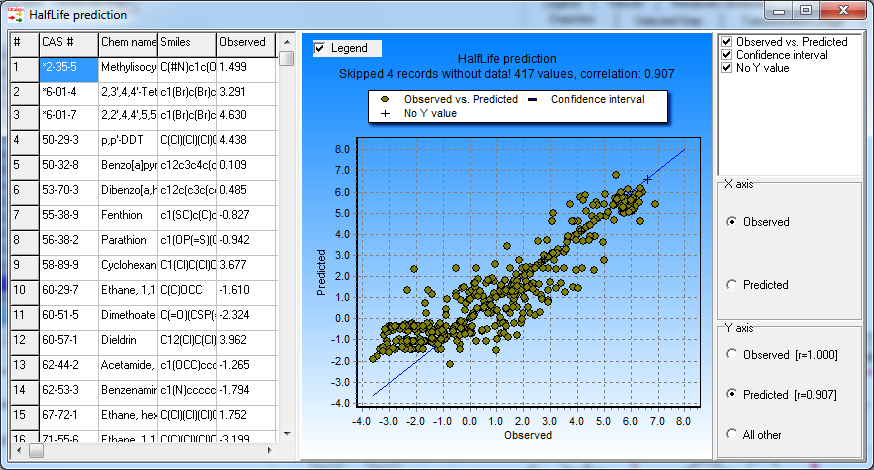Half-life model in fish
Endpoint
Half-life model predicts the whole body primary biotransformation half-lives (HL) for organic chemicals in fish.
Data
The training set of the model consists of 417 chemicals with observed values for half-lives in fish [1]. Another training database of documented fish and rat liver transformation maps for 433 organic compounds and expert knowledge was used to determine the principal transformations and to train the system to simulate the fish liver metabolism of training chemicals. The documented pathways were collected from scientific papers, monographs and databases accessible over the Internet.
Model
First order kinetics and a probabilistic approach were used to develop the model.
![]()
![]()
![]()
where:
[A]0- initial concentration of parent chemical,
[A]- quantity of parent chemical at time t,
kM - apparent kinetic constant,
ki - metabolic kinetic constant of transformation i,
t1/2 - parent half-life.
Non-linear least square method was used to parametrize the model:
![]()
where RSS is the residual sum of squares, HLjObs and HLjCalc are observed and predicted half life data of training chemicals and k is a vector of estimated kinetic constants of transformations.
Domain
The stepwise approach [2] was used to define the applicability domain of the model. It consists of the following sub-domain levels:
- General parametric requirements - includes ranges of variation log KOW and MW,
- Structural domain - based on atom-centered fragments (ACFs).
A chemical is considered In Domain if its log KOW and MW are within the specified ranges and if its ACFs are presented in the training chemicals. The information implemented in the applicability domain is extracted from the correctly predicted training chemicals used to build the model and in this respect the applicability domain determines practically the interpolation space of the model.
Performance
The goodness of fit evaluated by the squared coefficient of correlation is R2 = 0.82
The model correctly predicts 85% from the training set chemicals.
Reporting
The model provides results for:
- Whole body primary biotransformation half-lives (HL) for organic chemicals in fish, days,
- Apparent kinetic constant, days-1,
- Quantities of parent and first level metabolites, mol/mol parent,
- Applicability domain details.
References
1. JA. Arnot, D Mackay, TF. Parkerton, M Bonnell, Environmental
Toxicology and Chemistry, 27 (2008), pp. 2263-2270.
2. S. Dimitrov, G. Dimitrova, T. Pavlov, N. Dimitrova, G.
Patlevisz, J. Niemela and O. Mekenyan, J. Chem. Inf. Model. 45
(2005), pp. 839-849.

